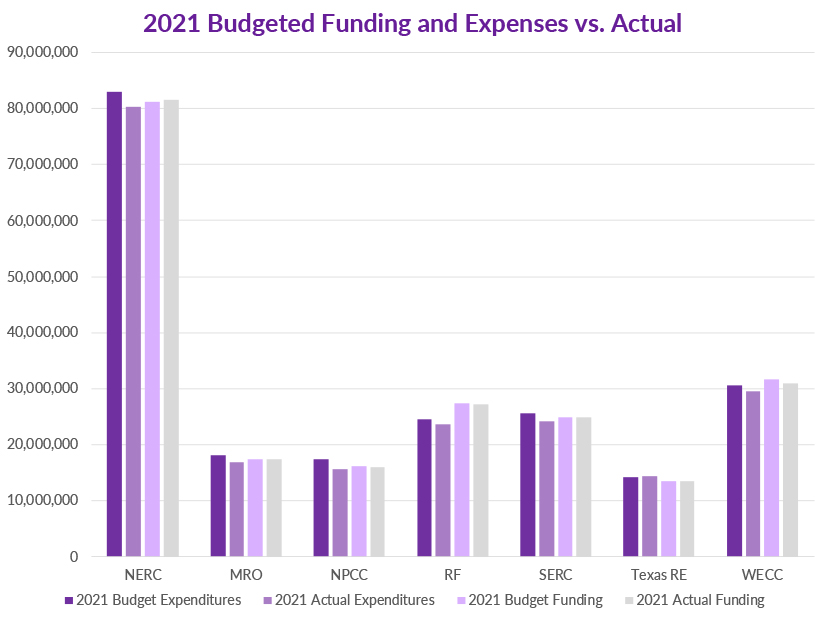
NERC and the regional entities continued to see significant cost savings because of the COVID-19 pandemic last year, according to the ERO Enterprise’s yearly budget true-up report filed with FERC last week (RR22-3).
The commission requires NERC to report the ERO’s cost-to-budget comparison every year, along with audited financial statements for itself and each RE, giving the reasons for significant differences between the planned and actual figures. The filing must also include a justification for any use of cash reserves and explanation for why their use constitutes “unforeseen events” and not “a means to fund expected projects outside of the budget approval process.”
According to last week’s filing, NERC and every RE besides the Texas Reliability Entity spent less than they expected in 2021. NERC’s savings were the largest at more than $2.5 million, though its $80.3 million spending (actual) was also much bigger than any RE. Revenue was higher than planned for most entities, though Texas RE, SERC Reliability and the Northeast Power Coordinating Council reported their actual funding was lower than they had projected.
While NERC and the REs had factored some continued cost savings from the pandemic into their 2021 budgets, the ongoing shutdown of almost all business travel and cautious return-to-office policies across the ERO Enterprise meant entities spent even less than expected. (See NERC Aims for Cost Control in 2021 Budget.) NERC’s meetings and travel category, for instance, came in $1.9 million underbudget and personnel expenses were underbudget by $150,000, partly from “lower parking and transportation benefits due to the pandemic.”
Other entities told a similar story: The Midwest Reliability Organization spent just $5,904 of its $963,000 meeting and travel budget in 2021, and ReliabilityFirst similarly saved over 92% of its $980,000 budget for the same line item. Only WECC saw a savings of less than 90%, spending $58,097 of its $378,000 meetings and travel budget in 2021.
Some entities saved money last year by doing work inhouse that they had planned to outsource to consultants or contractors; NPCC, for example, replaced independent compliance auditors with full-time staff. NERC said that “increased experience and expertise gained by entity staffs, and implementation of process efficiencies, has enabled entity staffs to perform and complete work for which consultants or contractors were previously used.”
Despite the overall savings, however, several entities did report overspending in some categories, particularly personnel. For instance, although NERC’s personnel expenses were underbudget overall, the entity said the savings were largely from the capitalization of certain labor costs associated with various projects; without this capitalization, the category would have been $362,000 overbudget.
SERC and NPCC also reported greater-than-expected spending on salaries; in NPCC’s case, this was part because of the use of inhouse staff rather than consultants for compliance audits. SERC said its expenses were from raising compensation for critical staff because of market demand, along with incentives paid out by its Board of Directors for “exceeding corporate strategic initiatives and key performance indicator goals.”
NERC and the REs are currently accepting comments on their draft 2023 business plans and budgets, which they posted last month. (See NERC Plans Big Budget Hike for 2023.) The total ERO Enterprise budget is set to be $248.9 million, about $22.7 million more than the budget for this year. NERC’s budget hike of $12 million represents the lion’s share of the increase, but all REs are planning to raise their spending as well because of the current high inflation rate in the U.S. and the need for investments in cybersecurity. (See ERO Warns Inflation, Cyber Investments to Keep Boosting Budgets.)

